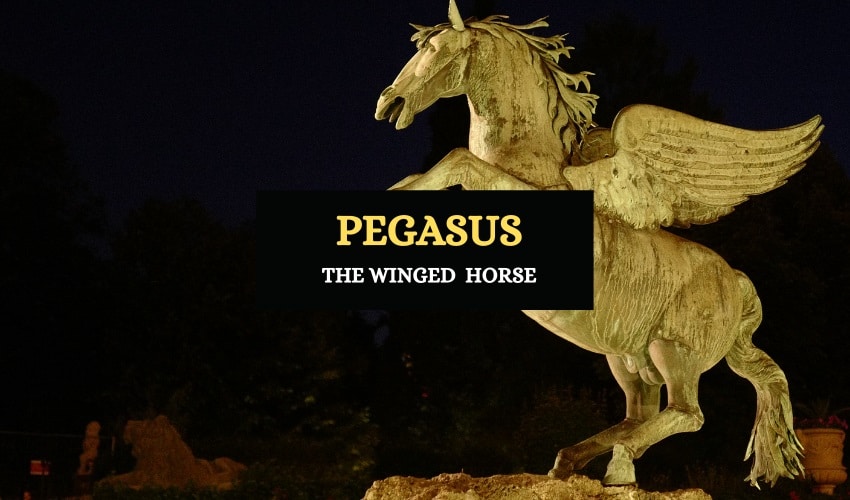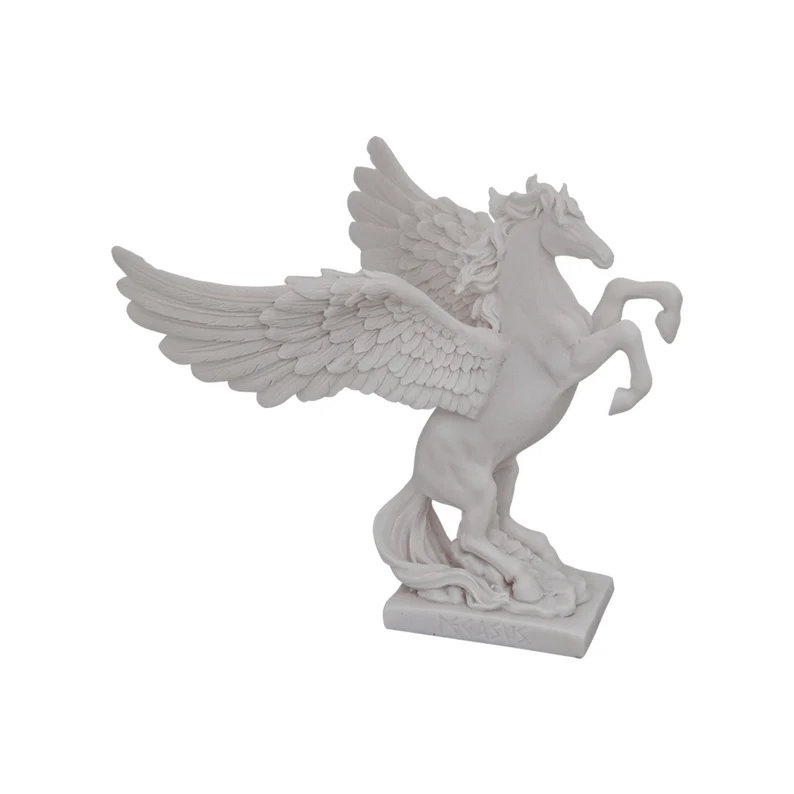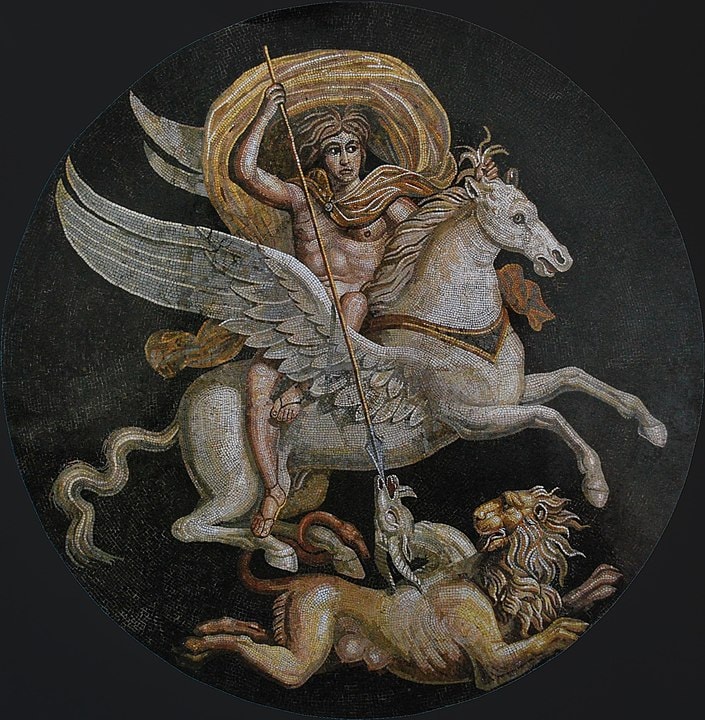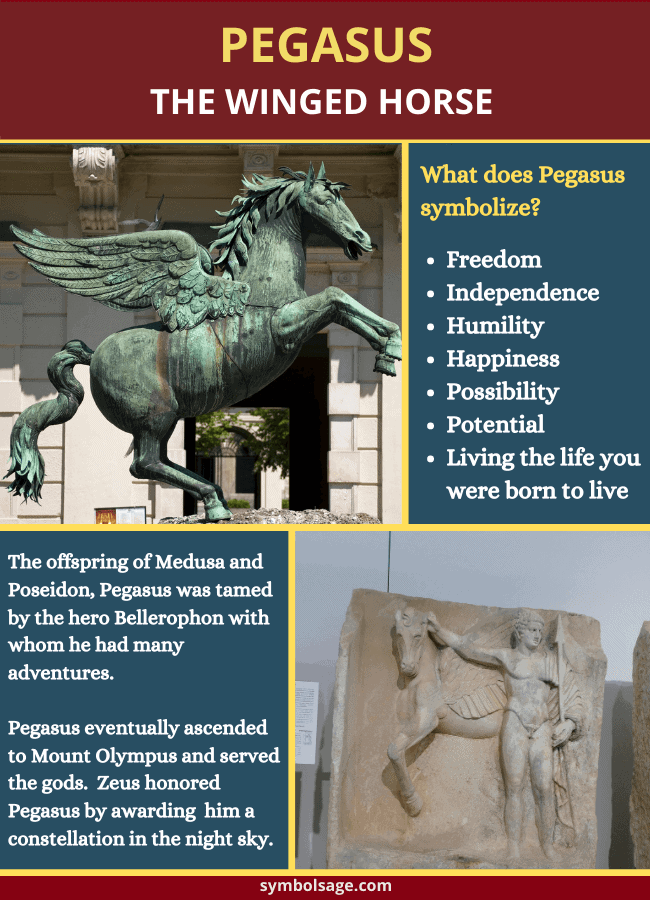
Table of Contents
One of the most intriguing characters of Greek mythology, Pegasus was the son of a god and a slain monster. From his miraculous birth to his eventual ascension to the abode of the gods, Pegasus’ story is unique and intriguing. Here’s a closer look.
Origin of Pegasus

Pegasus was the offspring of Poseidon and the Gorgon, Medusa. He was born in a miraculous way from Medusa’s severed neck of Medusa, along with his twin brother, Chrysaor. His birth occurred when Perseus, son of Zeus, beheaded Medusa.
Perseus had been commanded by King Polydectes of Seriphos to kill Medusa, and with the aid of the gods, the hero managed to decapitate the monster. As a son of Poseidon, Pegasus is said to have had the power to create streams of water.
Pegasus and Bellerophon

Pegasus’ myths are mainly related to the stories of the great Greek hero, Bellerophon. From his taming to the great feats they accomplished together, their stories are intertwined.
- Pegasus’ Taming
According to some myths, the first of Bellerophon’s great deeds was to tame the winged horse while he was drinking from the fountain of the city. Pegasus was a wild and untamed creature, roaming freely. Bellerophon was aided by Athena when he decided to tame Pegasus.
However, in some other myths, Pegasus was a gift from Poseidon to Bellerophon when he started his journey to become a hero.
- Pegasus and the Chimera
Pegasus played an important role in the slaying of the Chimera. Bellerophon flew on Pegasus to complete the task, with Pegasus steering clear of the deadly fire blasts of the creature. From a height, Bellerophon was able to kill the monster unharmed and complete the task king Iobates had commanded of him.
- Pegasus and the Symnoi Tribe
Once Pegasus and Bellerophon had taken care of the Chimera, King Iobates commanded them to combat his traditional enemy tribe, the Symnoi. Bellerophon used Pegasus to fly high and throw boulders at the Symnoi warriors to defeat them.
- Pegasus and the Amazons
The myths say that Pegasus’ next quest with Bellerophon was to defeat the Amazons. For this, the hero used the same tactic he used against the Symnoi. He flew high on the back of Pegasus and threw boulders at them.
- Bellerophon’s Vengeance
Stheneboea (also known as Anteia or Cyane) was the daughter of King Iobates of Lycia and the wife of Proetus, who was a king of Argos and later of Tiryns in Greek mythology. Stheneboea is a significant character in the myth involving Bellerophon, a famous Greek hero.
According to the myth, Stheneboea developed an infatuation for Bellerophon, but he rejected her advances. In retaliation, Stheneboea lied to her husband Proetus and claimed that Bellerophon had tried to seduce her. Angered, but unwilling to kill a guest directly (as it would violate the sacred rules of hospitality, known as xenia), Proetus sent Bellerophon to King Iobates with a sealed message. The message asked Iobates to kill Bellerophon, initiating the hero’s famous set of impossible tasks, including the slaying of the Chimera.
When Bellerophon succeeded in all his tasks and his innocence was revealed, Stheneboea, stricken with guilt or fear, ended her own life. There are several versions of this tale, and in some, she lives out her life in ignominy after Bellerophon’s rise in esteem.
- Flight to Mt. Olympus
The adventures of Bellerophon and Pegasus ended when Bellerophon, full of arrogance and hubris, wanted to fly to the abode of the gods, Mt. Olympus. Zeus would not have it, so he sent a gadfly to sting Pegasus. Bellerophon was unseated and fell to the ground. Pegasus, however, kept flying and arrived at the dwelling of the gods, where he would remain for the rest of his days serving the Olympians.
Below is a list of the editor’s top picks featuring the statue of Pegasus.
Pegasus and the Gods
After leaving Bellerophon’s side, the winged horse began to serve Zeus. Pegasus is said to have been Zeus’ thunderbolt-bearer whenever the king of the gods needed them.
According to some sources, Pegasus carried several godly chariots through the skies. Later depictions show the winged horse attached to the chariot of Eos, the goddess of dawn.
Eventually, Pegasus was awarded with a constellation by Zeus, to honor him for his hard work, where he remains to this day.
The Spring of Hippoccene
Pegasus is said to have had powers related to water, which he derived from his father, Poseidon.
The Muses, the goddesses of inspiration, had a contest on Mount Helicon in Boeotia with the nine daughters of Pierus. When the muses began their song, the world stood still to listen – the seas, the rivers, and the skies were silenced, and Mount Helicon began to rise. Under Poseidon’s instructions, Pegasus struck a rock on Mount Helicon to keep it from rising, and the stream of water began to flow. This was known as the Spring of Hippocrene, the sacred Spring of the Muses.
Other sources propose that the winged horse created the stream because he was thirsty. There are tales of Pegasus creating more streams in different regions of Greece.
The Pegasoi
Pegasus was not the only winged horse in Greek mythology. The Pegasoi were the winged horses who carried the chariots of the gods. There are tales of the Pegasoi being under the service of Helios, the god of the sun, and Selene, the goddess of the moon, to carry their chariots across the skies.
Pegasus’ Symbolism

Horses have always symbolized freedom, independence and liberty. Their connection with mortals fighting battles have further strengthened this association. Pegasus, as a winged horse, has the additional symbolism of the freedom of flight.
Pegasus also symbolizes innocence and serving without hubris. Bellerophon was unworthy of the ascension to the heavens since he was driven by greed and pride. Yet, Pegasus, who was a creature free from those human emotions, could ascend and live among the gods.
Thus, Pegasus symbolizes:
- Freedom
- Independence
- Humility
- Happiness
- Possibility
- Potential
- Living the life we were born to live
Pegasus in Modern Culture
There are several depictions of Pegasus in today’s novels, series, and movies. In the movie Clash of the Titans, Perseus tames and rides Pegasus and uses him to accomplish his quests.
The white Pegasus of the Hercules animated movie is a well-known character in entertainment. In this depiction, the winged horse was created by Zeus from a cloud.
Besides entertainment, the symbol of Pegasus has been used in wars. In the second world war, the insignia of the Parachute Regiment of the British Army features Pegasus and Bellerophon. There’s also a bridge in Caen that was known as the Pegasus Bridge after the attacks.
In Brief
Pegasus was an important piece in Bellerophon’s story and was also an important creature in the stables of Zeus. If you think about it, Bellerophon’s successful feats were only possible because of Pegasus. Taken this way, the story of Pegasus indicates that gods and heroes were not the only important figures in Greek mythology.











